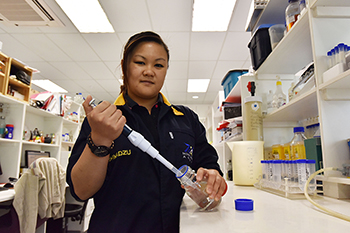Latest News Archive
Please select Category, Year, and then Month to display items
11 March 2021
|
Story Rulanzen Martin
|
Photo Courtesy of the artists
![]()
The annual final-year Fine Arts graduate exhibition promises to once again entice even the biggest of art enthusiasts. The exhibition, which runs until 1 April 2021, highlights the artworks/projects of final-year students in the Department of Fine Arts.
 Louiza Combrinck, World-building, Digital print, 84 x 49 cm. Image courtesy of the artist.
Louiza Combrinck, World-building, Digital print, 84 x 49 cm. Image courtesy of the artist.
 Final-year graduate exhibition at the Johannes Stegmann gallery
Final-year graduate exhibition at the Johannes Stegmann gallery
 Monique Myburgh, Digital Atoll I, Digital drawing, 70 x 100 cm. Image courtesy of the artist.
Monique Myburgh, Digital Atoll I, Digital drawing, 70 x 100 cm. Image courtesy of the artist.
 Elizabeth Bosch, Blau Macht mich Traurig, Oil on wood, 80 x 62.5 cm. Image courtesy of the artist.
Elizabeth Bosch, Blau Macht mich Traurig, Oil on wood, 80 x 62.5 cm. Image courtesy of the artist.
 Shenique Roux, Perplexed Recollection, Digital print, 40 x 100 cm. Image courtesy of the artist.
Shenique Roux, Perplexed Recollection, Digital print, 40 x 100 cm. Image courtesy of the artist.
The impact of personal care products on water resources in the Free State
2015-12-14

Jou-an Chen
Photo: Charl Devenish
|
Water is of the utmost importance in personal hygiene. Most people can hardly have a day go by without taking a shower in the morning and at night. However, it is this very habit that is increasingly polluting the water resources in South Africa.
Contaminants found in pharmaceutical and personal care products have been accumulating in water masses in recent years. These contaminants especially refer to hormones in medication, as well as colouring agents and fragrances used in soap, shampoo and body lotions.
“Little information and data are available on the prevalence of these contaminants, and on how high the level of pollution really is,” says Jou-an Chen, researcher in the Department of Microbial, Biochemical and Food Biotechnology at the UFS.
Her research particularly focuses on the prevalence and impact of those contaminants.
“Because these substances have not been properly investigated, we are not sure how widely it occurs and whether it is harmful to the environment. It was precisely the lack of information that has inspired me to investigate further.”
“If we could identify the contaminants and what it is doing to the environment, it could make a valuable contribution to directives on water quality standards.”